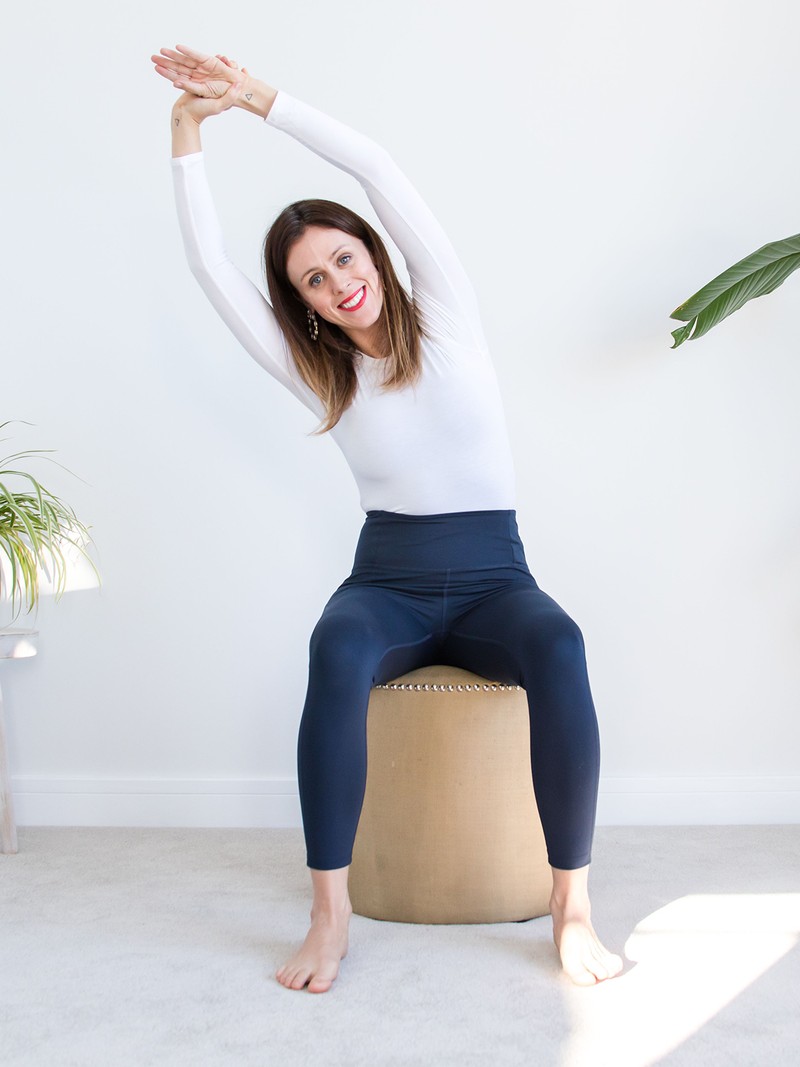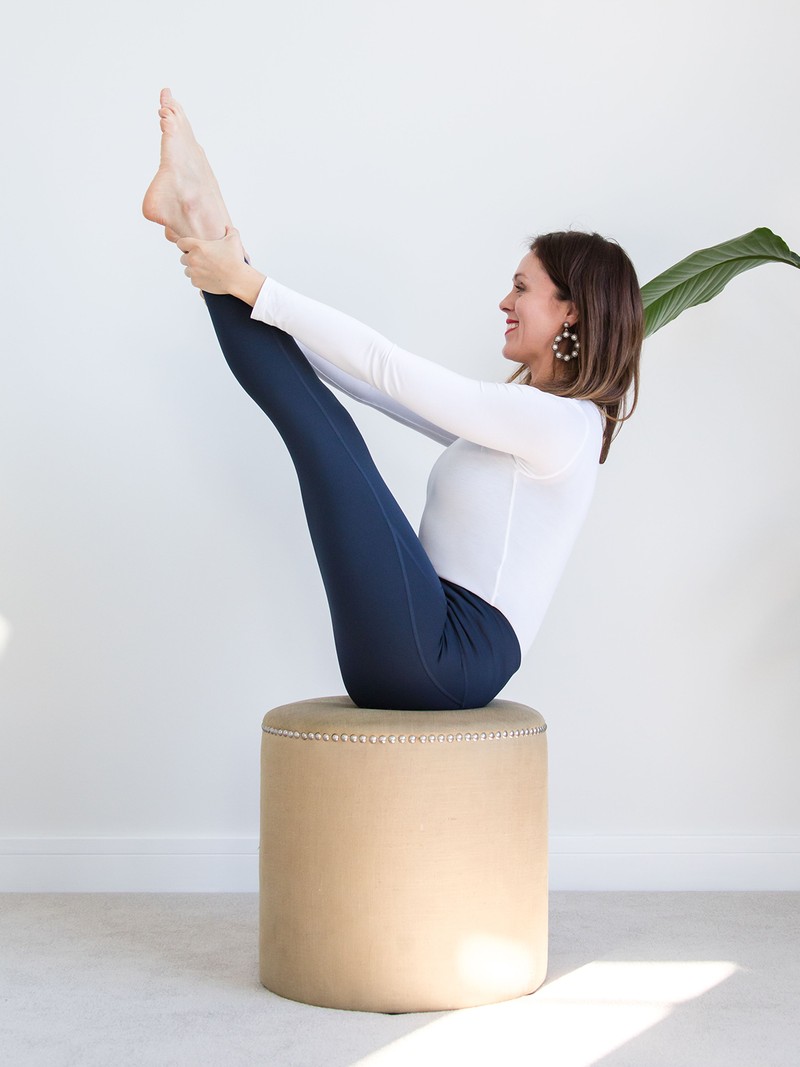How To Move More At Your Desk

Embrace Your Inner Fidget
“We’re conditioned to believe that movement is for when you’re in your activewear, working out at the gym. While regular exercise is great, this mindset works against us as it means we don’t move very much at other points during the day. I like to think of movement as a pie-chart, with the components being flexibility, strength and cardio – we want some of each, every day. Do what you love at the gym, get steps in throughout the day, and do Pilates or some light movement at your desk. All movement matters – every time you move a body part you use energy and hydrate the connective tissue that runs through your body, which increases your movement potential. For every 20-30 minutes you sit, you should move for a few minutes. Whether it’s wiggling your fingers, turning your head from side to side, or marching your legs while you sit, it all counts.”
Stop Sitting Like A Croissant
“The classic slouching position can be likened to a croissant or cashew. In this position, we tend to tuck our bottoms under and sit at the back of our sit bones, with the top part of the back rounded forward. There isn’t much muscle activation happening when we sit like this – the legs aren’t active, the tummy muscles are switched off and you’re potentially putting pressure on the lower back and the discs of the lower spine. This croissant position can also create a significant imbalance between the front and the back of the body. Lots of clients come to me with lower back, neck and shoulder pain – and almost all of them have been sitting in this position. Your sit bones are located at the bottom of your pelvis – they are the two bones under your bottom. You should aim to sit up on them, and when you do so, you’ll have a right angle where the back of your legs meets your torso on the chair. Keep your head in line with your spine, too. One way to check this is to interlock your hands behind your head and push your head back into your palms.”
Try Not To Cross Your Legs
“Crossing our legs is something we all do, but if you do it for hours on end, it can start to create imbalances across the hips and pelvis, potentially giving rise to back pain. When we cross our legs, our leg bones are either turned in or out in our hip sockets. One side of the pelvis (the leg crossing side) is lifted higher than the other, and our pelvis may also be rotated. This can cause an imbalance at the back of the pelvis, which over time can lead to aches and pains around the hips, lower back and further up the spine. Stick post-its around your desk to act as a reminder or try sitting with a small Pilates ball or cushion between your knees. Set a reminder to move every 30 minutes, even if it’s a full-body wiggle, to take you out of a sitting posture.”
Swap Your Chair For A Stool
“Sitting on a stool means you don’t have the opportunity to lean back into a chair, where you run the risk of poor posture. I’m not suggesting back rests don’t have a place, but if you do sit with one then try to mix it up. Start at the front of your chair rather than relying on the back rest all day. Sitting on a Swiss ball can also help – these work well as you can sit up on your sit bones and they add a stability challenge so you’re constantly moving to stay balanced – as can wobble pads.”
Try Elbow Swimming
“One of my favourite moves for the neck and shoulders is elbow swimming. Simply put your fingertips on your shoulders and then bring one elbow forward, followed by the other, and then go the other way. This is a great way to get your spine rotating, and you can turn your head from side to side to look at the back elbow as you go, too. This is a simple but fantastic way to improve mobility in your shoulders and ease upper back tightness.”
Breathe Deeply To Release Tension
“Not breathing properly or holding your breath can create tension in the neck and shoulders. If you struggle with sore, tight shoulders, try to incorporate a few deep breaths throughout the day. Also, make sure you are sitting up on your sit bones to stack your spine, and that you have your computer at eye height. It can also help to take regular movement breaks, and practice pressing your head back so it’s in line with your spine (pretend you have something smelly in front of your face) – this can make all the difference.”
Attach Movement To Things You Already Do
“A great time to move is while you’re waiting for something to happen – for example, you could take a shake break (I do this in all my workshops – you quite literally stand up and shake your body out) while waiting for a meeting to start or practice some toe lifts while waiting in a queue. You can also try linking a particular movement to an existing everyday task – in this way, the task becomes the ‘reminder’ to move. For example, when you turn your computer on in the morning, sit on your sit bones for the first five minutes and take five big breaths; raise and lower your heels six times when you press ‘go’ on the coffee machine; stand up and wiggle every time you get a glass of water; and move your spine at the end of every meeting. Write down three of your own movement enablers and stick them somewhere visible.”

Want To Learn More About Kerrie-Anne’s Method? Watch Her Here On The Latest SheerLuxe Show…
For more information or to book a session with Kerrie-Anne, visit PilatesAtYourDesk.com. You can also follow her on Instagram @PilatesAtYourDesk.
DISCLAIMER: Features published by SheerLuxe are not intended to treat, diagnose, cure or prevent any disease. Always seek the advice of your GP or another qualified healthcare provider for any questions you have regarding a medical condition, and before undertaking any diet, exercise or other health-related programme.
DISCLAIMER: We endeavour to always credit the correct original source of every image we use. If you think a credit may be incorrect, please contact us at info@sheerluxe.com.


